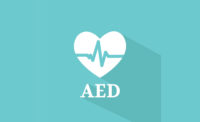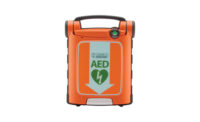AEDs on the wall are not an AED program
Roles, maintenance & response times

Many organizations have invested in automated external defibrillators (AEDs), medical devices designed for use by lay people to give victims of one of the nation’s leading killers — sudden cardiac arrest (SCA) — a fighting chance at survival. With upwards of 395,000 people experiencing SCA outside of hospitals each year in the U.S., and the fact survival depends upon access to an AED within minutes, more organizations of all sizes are recognizing the critical importance of having AEDs onsite in the event they are needed.
But having AEDs is not the same as having an AED program. True success in the form of an AED program involves preparation and performance, and requires knowledge, proper set-up and ongoing and careful management.
Know the rules
So, what is an AED program anyway? An AED program is a set of policies and processes — as well as the equipment and people resources to support them—that prepare your organization for SCA emergencies. AED program rules — which include both industry standards and AED laws — guide what to include in your organization’s AED program policies. Knowing and following these rules enables you to:
- Responsibly design, set up and operate your AED program;
- Prove you are compliant with the rules (industry standards + AED laws); and
- Defend yourself in court and avoid financial penalties if your organization gets sued
Now let’s take a closer look at what constitutes these rules.
First, industry standards (also referred to as the “standard of care”) are a broad set of guidelines that help you organize the people, systems, equipment and activities surrounding your AEDs, plus a set of practices ensuring your organization performs responsibly before and during a sudden cardiac arrest. These standards apply to every organization with AEDs, though specific practices will vary for every organization.
Second, state AED laws include a set of statutes (from state legislatures) and regulations (from state agencies) defining how to own, place and use AEDs. These laws touch on three topics:
- AED Law Requirements: Things organizations must do to administer and operate an AED program. Examples include properly inspecting and maintaining AEDs, training people, receiving medical direction, reporting to agencies, and more;
- Good Samaritan Immunity: Legal protections for AED program organizations and people; and
- AED Placement Mandates: Directives that apply to certain types of organizations indicating they must have AEDs. Examples include health clubs, schools, high-population buildings, and others.
Each state’s AED laws are different and not every state’s AED laws include AED law requirements or AED placement mandates. And, there may be local laws that must also be followed. It’s important to know and understand what laws apply to you and your organization.
Laws are not industry standards
Let’s be clear, industry standards and AED laws are two key, but distinctive, pieces of the AED program rules. That said, contrary to popular belief, AED laws do NOT equate to industry standards. Your organization can follow AED law requirements and still be unprepared for, or perform poorly during, a cardiac arrest. This is because AED law requirements don’t spell out many of the things found in industry standards. And you’re not likely to find AED program success without ensuring both are well covered.
While AED laws direct you to meet high-level requirements, they do not prescribe broader standards that will make your efforts successful. So, by focusing only on addressing AED law requirements, you can see below how your organization’s AED program would be likely to fall short.
Requirements and standards
Common AED law requirements are statutory and regulatory directives imposing operational obligations on AED programs (Not all AED law requirements exist in all states — each state is different):
- Properly inspect and maintain AEDs
- Properly inspect and maintain AEDs
- Notify specified agencies of the presence of AEDs
- Get “medical direction”
- Ensure AED users activate the emergency medical services system
- Report AED uses to someone
- Create AED program documentation
- Plus, states may impose a wide variety of other unique obligations, most unrelated to preparation or performance
Universal AED program industry standards are policies and practices supporting cardiac arrest preparation and performance:
- Identify key operational characteristics of each AED program site
- Assign people to defined AED program administrative and operational roles
- Define AED response areas for each AED program site
- Set a reasonable AED response time objective for each AED response area of each AED program site
- Select AED placement locations in each AED response area that allow response time objectives to be met
- Develop and follow a phased AED deployment plan if all needed AEDs will be placed over time
- Place AED equipment, accessories and supplies at each AED placement location
- Put in place a reasonable AED storage, security and access program
- Put in place an AED equipment inspection, maintenance and replacement program
- Assign trained and untrained people to defined AED response team roles
- Put in place a reasonable, formal and general CPR/AED training program
- Put in place internal, external and cardiac arrest event communications systems
- Fully document compliance with industry standards and AED law requirements
Set up your program
So, how can your organization successfully set up and manage your AED program? It all starts with the AED program design. A comprehensive AED program design leads to a complete set of policies and practices that prepare your organization for SCA emergencies and significantly increase the chances your people will perform well when SCA strikes. When you complete the AED program design process, you will know:
- Roles and assignments for your AED program staff
- Acceptable AED response times defining how fast to get and use an AED
- How many AEDs you should have for your locations
- Where you should place each AED
- How to properly store each AED
- Where AEDs should and should not be located
- A phased approach for growing your AED program over time
- Who can get an AED during an emergency
- Who can use an AED during an emergency
- How to educate your staff and others about your AED program
- How to properly inspect and maintain your AEDs
- Why, when and how to notify outside agencies about your AED program
- Where to place signs to help people quickly find an AED in an emergency
- What training policies to have for your staff and bystanders to use AEDs
- If you need medical direction to stay legal and compliant
Putting in place a solid AED program design along with supporting policies and practices best prepares your organization to:
- Help save someone’s life if they have a cardiac arrest
- Ensure your people perform responsibly when cardiac arrest happens
- Reduce the risk of getting sued if something goes wrong
When you save a life, you will know all of this is well worth the effort. And when you see your AED program succeed, you’ll know it was definitely worth doing right.
Looking for a reprint of this article?
From high-res PDFs to custom plaques, order your copy today!





